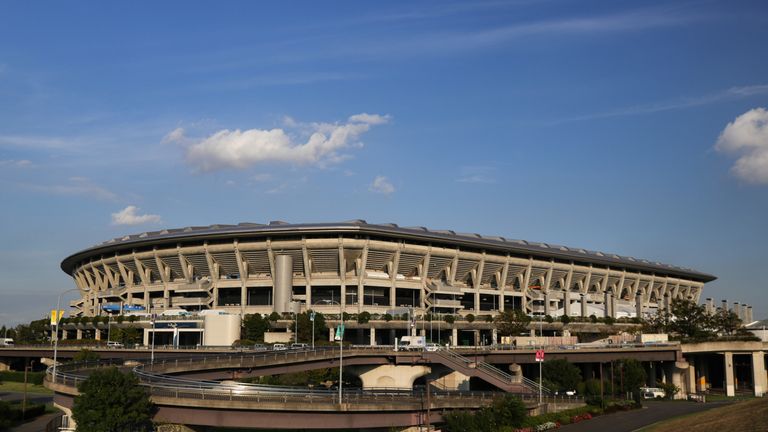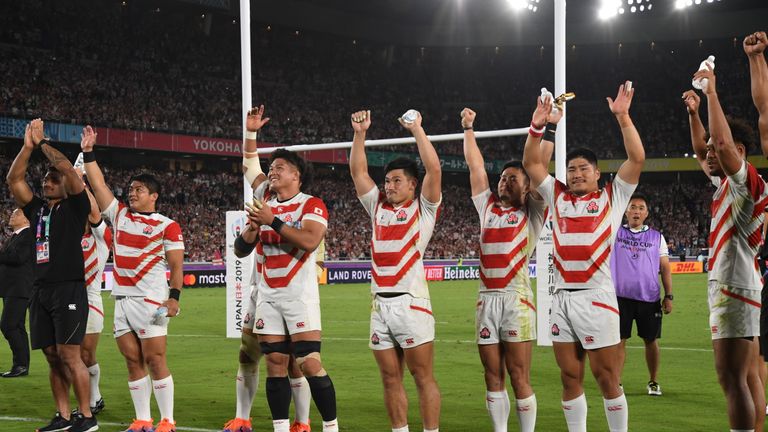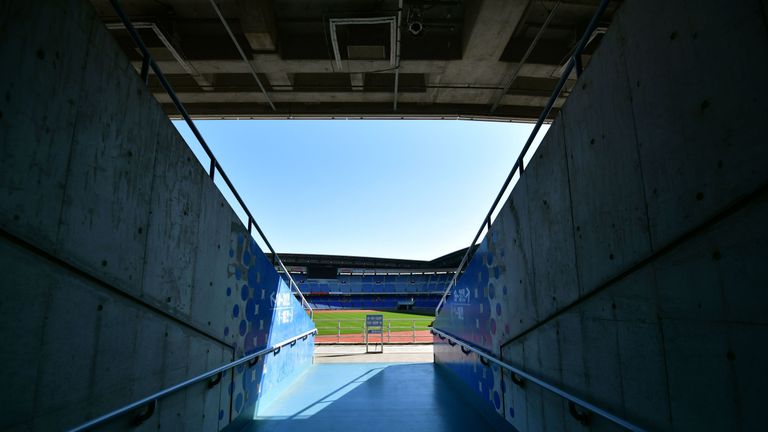Stadium Yokohama: Accidental Rugby World Cup venue ready for history
Rugby World Cup semi-finals: England vs New Zealand (Saturday 9am BST ko); Wales vs South Africa (Sunday 9am GMT ko)

Thursday 24 October 2019 06:14, UK
Sky Sports Rugby take a trip to the setting of Rugby World Cup 2019's two semi-finals this weekend - International Stadium Yokohama - to learn more about the intriguing structure's set-up, history and surroundings.
England and Wales will contest their first World Cup semi-finals for 12 and eight years respectively against southern hemisphere powerhouses the All Blacks and Springboks this weekend, having yet to play at the stadium.
Eddie Jones' side were meant to face France there in their final Pool C Test, before the match made history as the first World Cup game ever to be cancelled, due to Typhoon Hagibis. New Zealand and South Africa have played here once already, against each other back on September 21 in the opening fixture of Pool B.
As well as staging this weekend's two semi-finals, Stadium Yokohama - the largest stadium in Japan - will also host the final of this World Cup on Saturday, November 2.
Peeling back the layers of this enormous edifice, enclosed in grey concrete and raised several feet off the ground, there are some striking narratives…
********************
Departing Kozukue Station on foot, the differences in this expanse compared to Tokyo are stark and immediate.
A mix of contemporary Japanese houses and ones with distinctive, traditional Kirizuma-style roofs line the narrow streets leading to Stadium Yokohama, which is sat the other side of a main road.
It's far quieter than Tokyo here. It's less busy, less flashy. Less hustle and bustle, more suburban. The huge stadium - it's sheer size a first point of note - can be seen for miles above the surrounding low-rise buildings and herbaceous borders.
A note of caution for fans of competing nations in the semi-finals: Yokohama Station is nowhere near the stadium. It's roughly a two-hour walk according to various navigational apps. Don't make the mistake of pitching up there.
The two options to arrive via train to this Kanagawa prefecture are Kozukue Station and Shin-Yokohama Station - both are minutes away on foot. The former less than 10, the latter slightly more.
Regardless, the journey once pulled in to one of these stations is simple. The stadium is almost always in full glare and routes are adorned with posters from the 2015 World Cup in England - each of the 20 competing nations deliberately and noticeably represented.
To reach the gates of the stadium is a course quite unique. A maze of roads, bridges, pathways, steps and ramps guide the way, laced over one another.
Think the MacArthur Maze of roads in Oakland, but on a far smaller, pedestrian-sized scale.
Such an amalgamation of routes is due to the fact the stadium is raised on enforced stilts and pillars, situated high above the surrounding parklands.
This is because it was rather ingeniously constructed as a flood control basin, due to risk assessment carried out two decades ago during the stadium build in 1998.
Located next to the Tsurumi river, Stadium Yokohama literally has a reservoir function to cope with flooding. It's elevated above river-level so that the adjacent Shin-Yokohama park acts a catchment should the river overflow or burst its banks - exactly as it did preceding the Japan vs Scotland Pool A Test staged here in the aftermath of Typhoon Hagibis.
A purpose-built drainage gate then flows the water basin back into the river. Such a feat of inventive and resourceful engineering is how this ground managed to put on a Rugby World Cup Test in front of a full stadium of fans, the morning after the largest storm to hit Japan in 60 years.
There are three full levels beneath the stadium's ground floor. Within the bowels of the site sit sports clinics, gymnasiums, photo exhibitions, shops.
Near the East Gate, the distinctive scent of chlorine can be smelt - a water park uniquely built under and within the stadium the root. There are many seemingly inimitable facets to this place. There surely cannot be another rugby ground like it in the world?
Beneath and inside the stadium, the colour contrasts markedly to the block grey which covers the outside. There are shocks of green, red, blue.
And back onto the main level, behind the ticket gates are in excess of 72,000 striking blue and red seats.
A second word of caution for attending fans: like so many of the arenas in Japan for this World Cup, Stadium Yokohama was built as multi-purpose, and so a sizeable 400 metre track surrounds the pitch. Prepare to feel slightly removed from the play, albeit not from the atmosphere.
********************
The accidental prime venue
When a stadium is chosen to host not just pool matches, but both semi-finals and the final of a major sporting event, it can nearly be taken as read that it is the fulcrum of the tournament.
Yet, look into things more closely, and the reality is that Stadium Yokohama was never meant to be a part of this Rugby World Cup at all.
Japan has known it had the hosting rights to this World Cup for 10 years - dating back to 2009 when World Rugby took the unprecedented decision to announce the next two tournament hosts concomitantly. England were awarded 2015 and Japan 2019.
In late 2013, the Japan Rugby Football Union (JRFU) and World Rugby levied for expressions of interest from potential venues and went about explaining Test hosting requirements to such parties. Stadium Yokohama was not among these.
In May 2014, it was confirmed that 22 municipals from throughout Japan had put themselves forward and by November 2014, World Cup organisers announced this had been reduced to 14 received bids from localities.
Stadium Yokohama had declined to bid. The detail as yet unrevealed is that during the bidding process for the World Cup back in 2009, a core element to Japan's proposal had been the then unbuilt National Olympic Stadium.
Located in Shinjuku, Tokyo, it was planned to hold 85,000 people and constitute the site of the Rugby World Cup's opening game and finale fixtures, before homing the 2020 Tokyo Olympics.
In July 2015, however, the stadium idea was scrapped by Prime Minister Shinzo Abe due to public pressure over increasing building costs. An alternative design and architect was chosen in December 2015, but such a decision made the feasibility of using the stadium as a Rugby World Cup venue impossible.
It was only at this juncture, despite having no discernible relationship or history with rugby, or in fact to any plans for the upcoming Rugby World Cup, that Stadium Yokohama was brought on board. And it was done so as the location of four pool games, both semi-finals and the final no less. It's 72,327 capacity marking it out as the largest in Japan.
The stadium, which was built ahead of the 2002 FIFA World Cup in South Korea and Japan, has a rich sporting pedigree - just not a rugby one.
Even now, two playing pitches approaching either side of the stadium are bejewelled with football goals. Kids play in the shadow of the main structure with the round ball, blissfully unaware that three of the most important Tests in the history of rugby will be taking place here over the next week or so.
This is football country. It hosted four games at the 2002 World Cup, including the final between Brazil and Germany - Ronaldo scoring twice to seal Brazil's fifth crown.
It also hosted the 2001 Confederations Cup, the Intercontinental Cup between 2002 and 2004, as well as the Club World Cup in 2005, 2006, 2007, 2008, 2011, 2012, 2015 and 2016. It is the home of J1 League side Yokohama F. Marinos.
Ahead of this World Cup, it hosted two rugby matches, both in recent years: November 2017 when Australia beat Japan and October 2018 when New Zealand beat the Wallabies. Never before had the 15-man game been played there.
After this autumn, however, Stadium Yokohama will forever be linked with rugby in the annals too.
******************
A fascinating tale of sporting rivalry
Stadium Yokohama is also home to one of the most interesting tales of rivalry in sport.
As mentioned above, it was built in 1998 ahead of becoming a landmark venue for the 2002 FIFA World Cup.
Prior to 1998, there were two competing Yokohama football clubs: Yokohama Marinos and Yokohama Flugels in the top level of the Japanese league.
But after the completion of Stadium Yokohama, the Japan Football Association is said to have craved an undying legacy for the behemoth arena beyond 2002.
Their decision, it turned out, was to merge the two Yokohama rivals into a super club - with the thinking being a combination of both organisations would befit a stadium of such size.
Yokohama Marinos and Yokohama Flugels became Yokohama F. Marinos. Fans of the Flugels sensed this was not so much a merger, as a takeover and dissolution of their club. Much in the same way as Stade Francais' fans and players protested to Racing 92's potential 'takeover' of the Paris club during the 2016/17 season.
Stade fought and kept their club alive. For Flugels fans, their club was already dead and so their response was to create a new one.
Akin to AFC Wimbledon in response to MK Dons and FC United of Manchester in protest at the way the Glazer family run Manchester United, the creation of Yokohama FC under a socio-model as adopted by Barcelona, saw the club start at the bottom of Japanese football in 2001.
In the 18 years since, Yokohama FC have made it to the top division, but only once - 2007 - while the Marinos have never been relegated. Meaning the two clubs, now extreme rivals, have only met on four occasions.
But, rather like a script from a film, FC won the first-ever meeting between the two clubs: 1-0 on March 10, 2007.
They lost the return fixture 8-1, lost a 2012 Emperor's Cup tie 2-1 and most recently, suffered a 2-1 defeat after extra time and after going 1-0 ahead in the fourth round of the 2018 Emperors Cup.
It's a fascinating tale of sporting rivalry and it all originates from Stadium Yokohama.


















